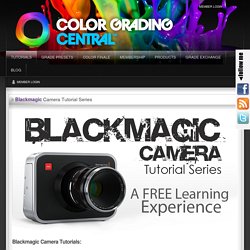

Inspiration. Ressources. The Blackmagic Production Camera 4K Guide (Part Two): Lenses, Filters, Matteboxes and Follow Focus Systems. By Sareesh Sudhakaran Disclosure: Links in this post may be to our affiliates; sales through affiliate links may benefit this site.

Please help support wolfcrow and buy from B&H and Amazon . It won’t cost you anything extra. Disclaimer: Since the Blackmagic Production Camera 4K isn’t out yet at the time of this writing most of this guide is conjecture – the result of relying on information provided by Blackmagic Design, educated guesses and my personal experience and analysis. In Part One we looked at ergonomics and specifications of the Blackmagic Production Camera 4K. About the Sensor and Super 35mm I won’t be going into details about how I choose lenses, because I’ve already covered a lot of ground here: What Lens to Get? The Blackmagic Production Camera 4K has a Super 35mm-sized sensor. The traditional 3-perf Super 35mm size is 24.89 mm x 14 mm with an aspect ratio of 16:9. The Blackmagic Production Camera 4K sensor measures 21.12 mm x 11.88 mm. Wow. Lens Adapters. Blackmagic Camera Tutorial Series. Blackmagic Camera Tutorials: More COMING SOON!

About this Series When the Blackmagic Camera stole the news at NAB in 2012, I knew right then and there that I had to get my hands on one. For the first time ever a camera was being offered with 12 bit RAW recording at a revolutionary price point of around $3,000 USD. And not only were you getting a 2.5K RAW recording camera but you were also getting the world class DaVinci Resolve color grading software with the purchase of the camera. So what was I to do? I of course didn’t know where to start when I first opened the packaging and examined this new pieces of hardware. Excited with a challenge and loving to share my knowledge and insights with others I embarked on a journey to discover what this camera was all about, what it could do and all that it had to offer. La vidéo, une révolution dans la communication d'entreprise - APCE, agence pour la création d'entreprises, création d'entreprise, créer sa société,l'auto-entrepreneur, autoentrepreneur, auto-entrepreneur, auto entrepreneur, lautoentrepreneur, reprendre un.
Why use the video. Why online video is the future of content marketing. If it were five years in the future, would you be reading this article or would you be watching it?

As online video continues its inimitable rise, it's an interesting question to ponder. By 2017, video will account for 69% of all consumer internet traffic, according to Cisco. Video-on-demand traffic alone will have almost trebled. Leafing through a swathe of statistics on the subject, I'm hard pressed to find any indicator that doesn't suggest rapid growth. With online video quickly becoming a key means for people to satisfy their information and entertainment needs, small businesses that fail to include it in their internet marketing strategies will do so at their peril. Video is the future of content marketing. When it comes to potential reach, video is peerless.
The success stories of videos that have gone viral are legend. But is video really possible for small businesses? Always consider the audience you are trying to reach and ensure the video is relevant to them. Read more... Le Marketing Video : Comment réaliser des vidéos pour vendre vos produits. Taux de mémorisation. Lexique Taux de mémorisation Il existe différentes formes pour mesurer la mémorisation en fonction des éléments dont on souhaite se souvenir.

On répertorie cependant un élément de comparaison des facultés de mémorisation des messages liés à chaque média : le bêta de mémorisation de Morgensztern qui est la référence pour fixer l'incidence publicitaire éventuel de chaque média et les éventualités mémorisation d'une campagne en fonction du taux de répétition. Le taux de mémorisation, aussi appelé facteur bêta de Morgensztern permet donc de transcrire le pourcentage d'individus qui après avoir été exposé la première fois au message ont mémorisé la marque et au moins un élément du message.
On considère que les taux de mémorisation des grands médias traditionnels sont : Cinéma 75 % Affichage 9,5 % Start With Why - Simon Sinek TED talk. Ref createur entreprise.